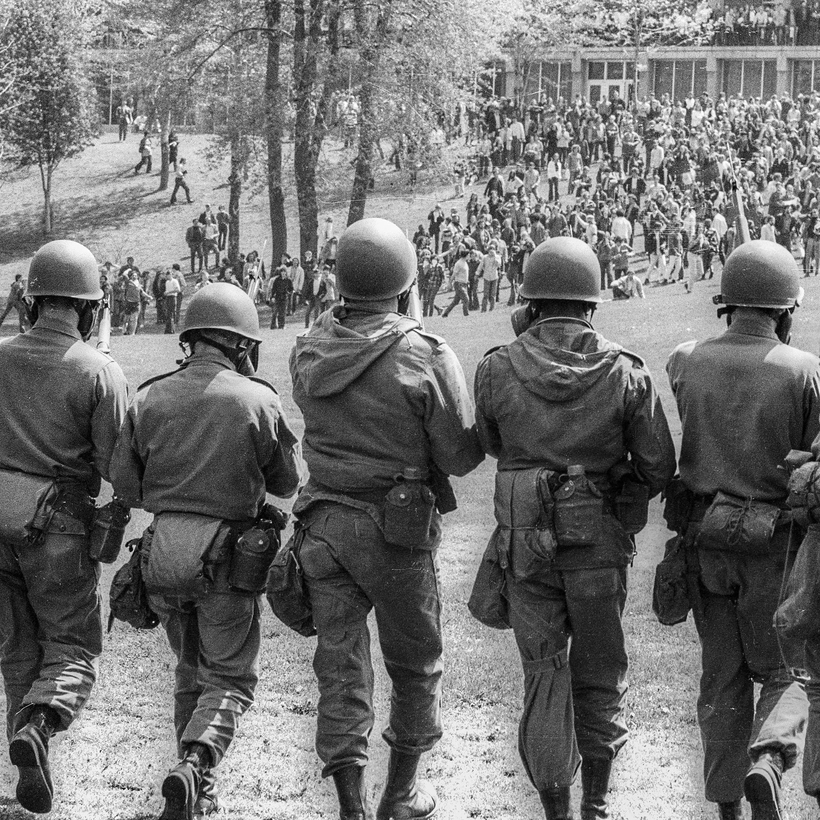Nearly all of the Ohio Army National Guardsmen involved in the Kent State shooting, on May 4, 1970, have remained silent since that bloody day—whether out of fear of legal consequences, guilt and shame over what happened, or trauma precipitated by the tragedy. The guardsmen’s half-century of silence created a vacuum that was filled with speculation. Why did they fire 67 shots in 12.53 seconds at unarmed college students protesting the Vietnam War, killing four and wounding nine others, with one paralyzed for life? Was an order to fire given, and, if so, by whom?
In 2012, at a news conference about the Kent State shooting, Dean Kahler, a protester confined to a wheelchair since that day, implored the guardsmen to help resolve the mystery. “It’s important to get the truth out before it’s too late,” he said.
It took more than 50 years, but Matt McManus, who was a 25-year-old platoon sergeant of the Ohio Army National Guard at the Kent State protest, finally answered Kahler’s plea. When I wrote to McManus in the fall of 2020 requesting an interview, I wasn’t confident he would reply. But he did—affirmatively. He wanted to get something off his chest, make peace with things, and correct the historical record before it was too late.

“Enough time has passed,” said McManus, who left the National Guard shortly after being acquitted at the 1974 criminal trial for the shooting. “I’m going to tell you only the truth. I’m not afraid of what’s down the pike.” A long silence followed. “We need to remember the students who died and were wounded that day.” McManus wanted “a face-to-face discussion,” because “it’s best to look into one’s eyes and feel the pain he or she may be experiencing.”
Three weeks later, I traveled to McManus’s home, in Wooster, Ohio. I feared he would change his mind at the last minute. But he didn’t.
We sat down in the living room of his modest ground-floor apartment. He had a sad face and looked exhausted—not the kind of exhaustion that can be healed by a good night’s sleep. His body was rigid. Much of the time he looked at me, but his haunted eyes never quite met mine. Occasionally he cast his eyes at the floor or stared out the window, concentrating on something only he could see.
Why did they fire 67 shots in 12.53 seconds at unarmed college students protesting the Vietnam War, killing four and wounding nine others, with one paralyzed for life?
For the first time, he unburdened himself completely about Kent State, pouring out his pain and regret. He confessed that, on May 4, 1970, he shouted a desperate order to “fire in the air” just before the shooting started, rather than just after the shooting started, as he had told investigators, journalists, and attorneys for 50 years.

McManus said he ordered fellow guardsmen to fire warning shots into the air in an attempt to avert violence. He never dreamed that his well-intentioned effort to prevent bloodshed would instead trigger it. The gas masks guardsmen wore muffled his voice, and the crowd’s noise made it very difficult to hear him. Some guardsmen only heard, or only listened to, the first word of McManus’s order and reacted, opening fire on the students.
It was a long-postponed catharsis. I couldn’t tell which one was strongest: his relief or his shame.
McManus’s startling confession is crucial to understanding the tragedy. Events that had baffled people for more than 50 years suddenly made sense.
We want to find sense in the senseless. When we can’t see a reason, we make assumptions and force facts into preconceived patterns until a reason takes shape. McManus’s belated confession is a powerful reminder that reality is tumultuous, disordered, and unpredictable. But learning the truth can be devastating, too.
Brian VanDeMark teaches history at the United States Naval Academy, Annapolis, and is the author of several books, including Road to Disaster and American Sheikhs

